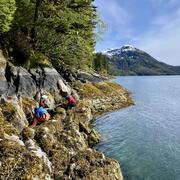Wildlife Disease
Wildlife Disease
Filter Total Items: 9
Harmful Algal Bloom Toxins in Alaska Seabirds
Elevated ocean temperatures are linked to the development of harmful algal blooms (HABs). Toxins from these blooms may pose health threats to marine organisms, including seabirds. Since 2015, the USGS has worked with a variety of stakeholders to develop testing methods and research projects to better understand the geographic extent, timing and impacts of algal toxins in Alaska marine ecosystems...
Avian Influenza Research
Since 2006, the USGS Alaska Science Center has been part of the State and Federal interagency team for the detection and response to highly pathogenic (HPAI) viruses in North America. Avian influenza or "bird flu" is a viral disease that primarily infects domestic poultry and wild birds. Avian influenza viruses are naturally occurring in wild birds such as ducks, geese, swans, and gulls. These...
Changing Arctic Ecosystems
Arctic regions of Alaska are important for cultural and economic sustainability and host a wide variety of wildlife species, many of which are of conservation and management interest to the U.S. Department of the Interior. The USGS and collaborators provide information about Arctic ecosystems that are used by Arctic residents, management agencies, and industry.
ASC Ecosystems Data Releases
Alaska Science Center Ecosystems data releases are grouped by topic: Terrestrial Ecosystems, Aquatic Ecosystems, Wildlife Health and Genetics, Environmental Health and eDNA, Habitat and Landscape Change, and Ecosystem Analytics.
Q&A: USGS Ecosystems Provides Objective Science to Manage Lands, Fish, and Wildlife
The USGS Ecosystems Mission Area is the only program within the Department of Interior (DOI) focused on generating science to inform the management of the nation’s lands, fish, and wildlife. The Ecosystems Mission Area is also the only entity with the specific role of meeting the information needs of DOI agencies (e.g., Bureau of Land Management, Bureau of Ocean Energy Management, National Park...
Beak Deformities in Landbirds
Over the past 26 years, Alaskans have witnessed a startling increase of beak deformities among Black-capped Chickadees and other species of resident birds. This disease, called avian keratin disorder (AKD), is characterized by debilitating beak overgrowth and other abnormalities of keratinized tissues. Affected birds have difficulty feeding and preening and may suffer high rates of mortality. If...
Wildlife Disease and Environmental Health in Alaska
Environmental health is defined by connections between the physical environment, ecological health, and human health. Current research within the U.S. Geological Survey (USGS) recognizes the importance of this integrated research philosophy, which includes study of disease and pollutants as they pertain to both wildlife and humans. Due to its key geographic location and significant wildlife...
Bird Migration and Influenza
The movement and transmission of avian influenza viruses in wild birds may differ by the migratory nature of each host species.
Seabird Die-offs in Alaska
Beginning in 2015, large numbers of dead seabirds have been appearing on beaches in most marine areas of Alaska. Although seabird die-offs are known to occur sporadically (e.g. 1970, 1989, 1993, 1997/1998, and 2004) in Alaska, these recent die-offs have been distinguished from past events by their increased frequency, duration, geographic extent, and number of different species involved.










